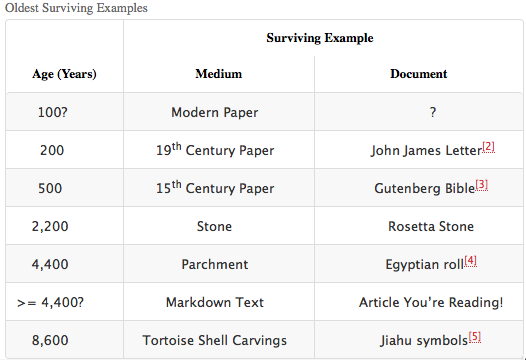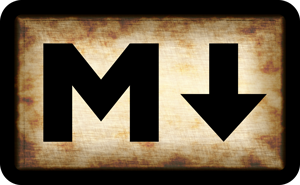If you want your words to last as long as parchment use plain ASCII text with Markdown. When found, your writing can be republished at the click of a button. It’s digital; make lots of copies.
Markdown is . . .1
… a way to format plain text to show the formatting choices of the writer.
The syntax is natural and the formatted text is readable (Unlike HTML from which Markdown was derived as a form of shorthand). And, since most publishing software can read Markdown, directly, the writer can write once, skip the hassles of formatting, and pass the text directly on to the publisher.
Half of the Markdown syntax is just how a writer would format text, naturally. For example, you type an asterisk or a number in front of bullet points or a list of items, or hit enter to separate paragraphs. Heading levels are marked by the number of “#” signs placed before the heading. Even footnotes, tables and web links are straightforward and the text remains readable after formatting.
Storage
Plain digital text bypasses the problems of paper storage. It also bypasses the format wars of proprietary software. Your writing is created, stored, and published from the same text file. If we can read Egyptian hieroglyphs, today, perhaps people will be able to read ASCII text files, 5000 years from now.
Ideally, you make a (Digital) book available and distribute it to hundreds or thousands of people. Upload it to a website where it will be indexed, and possibly stored, by a third party. Less ambitious writers could put their text on as many mediums as they can find. Put them in a safe, wrapped in a paper printout. Tell your family about them and put it in your will. If your lucky, your progeny will see it and use the search engine of the day to find a copy, somewhere. Otherwise, perhaps one of your digital copies is readable. In terms of survivability, the paper copy is likely the weakest contender after 100 years or so.
How Long Will it Last?

Search
The presumption, even today, is that if you have the title, or the author’s name, you have a fair chance of finding the book. As more books are published in digital-only formats the odds of being able to find any book will increase.
Write Once, Publish Anywhere
Markdown makes it possible to write once and publish anywhere. Every platform I’ve needed to publish to can receive markdown text. But, it’s even better than that: Most of my writing is outlined, written, edited, and exported directly to the publishing platform and archived in markdown from within one program: Scrivener. The text can then be updated or repurposed from the same place it’s archived! It’s hard to describe the relief of simplicity this workflow provides. It makes for a frictionless writing environment that shifts the focus of the work back onto content. You just keep writing and let the publishing platforms handle the formatting details.
Markdown Benefits
- Liberates the writer from formatting concerns both during, and after, writing.
- Liberates the writer from proprietary software jail.
- Gives the writer the widest number of choices in publishing platforms.
- Enables the writer to use the same text file to feed multiple software and publishing platforms.
- Updates and editions are made to one file: The original text file.
- Enables the text to be read now and for the foreseeable human future.
- Puts the writing in simple text format which will outlast all software programs currently in use.
- Text processing programs are everywhere as are publishing software and platforms that can read Markdown, directly. Pick one and start writing.
WYSIWYG Live Preview, Yes!
Ironically, writing in simple text was a big step for me. I worked as a typesetter before, and during, college and have always loved the look of well-formatted text and book design. My professional consulting is replete with word processors, project management software, presentations, adobe frame maker proposals, etc. To make it worse, I’ve relied heavily on HTML and InDesign for the past eight years. Must I do without the inspiration of formatted text to get all the benefits of writing in markdown?
Not at all! Marked reads your text file (Even a Scrivener file!) and displays a fully formatted version of your document in real time. As you type, Marked updates the displayed document. When you’re finished you can export the document from your original text editor or right from Marked, in all the standard formats.
Workflows
Website Articles
- Scrivener to WordPress.
- Markdownify plug-in within wordpress editor box.
- Images stored on dropbox or website image directory.
- Marked shows WYSIWYG of Scrivener file, including images, while the article is being written.
Guest posts
- Scrivener exported to publisher’s format preference.
A. Cut/paste of Markdown txt?
B. Html or pdf export from Marked
C. Other?
Client Documents
- Scrivener to pdf export.
- Indesign for special formats only.
Books
- Scrivener to first draft.
- Edit drafts in Scrivener.
- Send to Editor(s).
- Make edits in Scrivener.
- Final copy to Indesign.
- Format for Kindle, PDF, etc.
- Succeeding versions in Indesign.
Project Planning & Tasks
- Omnifocus (Text only)
- Drafts (MD and Text)
- Scrivener (MD and Text)
- Excel
E-mails
MailMate
Notes
- Evernote
- Nvalt
- Drafts (iphone/pad) to Evernote to Scrivener
Misc. Tools
- Byword
- Brett Terpstra’s Markdown services
- MultiMarkdown Composer
P.S., Nine Months Later
Shortly after starting to use Markdown I began using dictation software to talk words onto the screen. Dictation has now taken such a big place in my daily writing that my typing speed has declined. One thing I haven’t yet done is to train the dictation software to implement markdown syntax. For example, perhaps I could train the software so that saying, “Bold that”, puts double asterisks around the last word?
I no longer need Adobe Indesign or Word for daily writing. I much prefer to use Marked 2 for WYSIWYG of the draft folder of Scrivener. It’s not as good as Indesign but enough to be inspired by the clean text and formatting of what I’m working on.
When writing articles I sometimes use temporary droplink addresses of image files so Marked can show me how the picture will look with the text during the writing process. I also use droplink addresses to compose e-mails to friends (Also in markdown) if they’re to include photos. If I need the images to be viewable in the long-term I use “Transmit” to quickly upload the images to my website image directory and use that address in the markdown syntax.
When composing agendas and client documents I write them all in scrivener using markdown. I then use Marked to convert markdown to the pdf files that are sent directly to the client. Client work is started, and completed, in Scrivener where it remains in its final form. The pdf’s sent to the client are beautiful and archived in Scrivener.

Best Markdown Resources
- Book
- Article
- Cheat Sheets
- Spec
- WYSIWYG Live Preview
- Online Editors: Best are Dillinger and Stackedit.
- Online Live Preview
- Scrivener WYSIWYG using Marked 2
- Invented by John Gruber and Fletcher Penny. ↩
- https://www.whalingmuseum.org/explore/library/from-the-vault/cuffe-manuscripts ↩
- https://en.wikipedia.org/wiki/Gutenberg_Bible ↩
- David Diringer noted that “the first mention of Egyptian documents written on leather goes back to the Fourth Dynasty (c. 2550–2450 BC), but the earliest of such documents extant are: a fragmentary roll of leather of the Sixth Dynasty (c. 24th century BC) ↩
- Jiahu symbols, carved on tortoise shells in Jiahu, c. 6600 BC ↩




